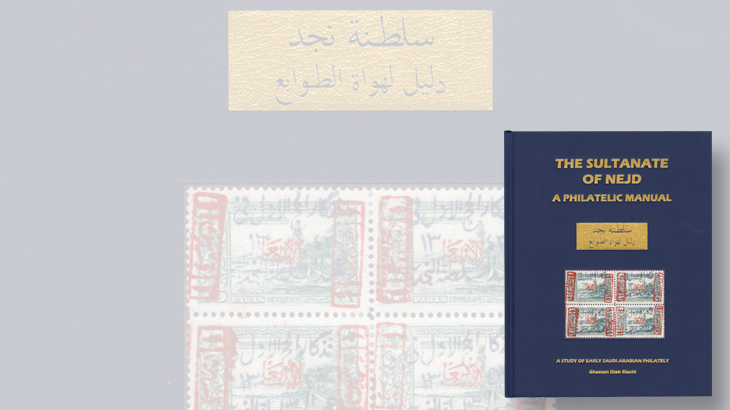World Stamps
New book makes Nejd Sultanate stamps, postal history accessible to novice and expert alike
Ghassan “Gus” Riachi announced in his Dec. 28 Middle East Stamps column the publication of his magnum opus: a work of 16 years titled The Sultanate of Nejd: A Philatelic Manual.
My association with Gus goes back more than a decade, when I began editing his monthly column, then published under the moniker Cradle of Civilization.
In a nod to the realities of the digital age, which require that online content be search-engine friendly, the column became Middle East Stamps.
As Gus explains in his column, collecting the stamps of the Nejd Sultanate presents some formidable challenges. Among these are rampant forgeries of the myriad handstamps and surcharges, and a lack of detailed information in stamp catalogs.
John M. Wilson, also a noted expert on the philately of Saudi Arabia, acknowledges the difficulties surrounding these stamps in his preface to the book: “The Nejd stamps are a complicated area for the collector, consisting entirely of Hejaz and Ottoman stamps with various kinds of rather crude handstamps.”
Although I’ve worked with the Scott catalogs for years, I freely admit that, prior to the arrival of Gus’ book, the listings for the early stamps of Saudi Arabia, including the Nejd, were mostly a mystery to me.
This new book, full of scholarly detail and sumptuously illustrated, makes this fascinating period in philatelic history accessible to novice and expert alike.
Indeed, as Gus explains in the foreword, his desire was to write a book that would be “readable to the general collector” while providing the necessary detail to “satisfy the needs of the advanced specialist.”
Before making any attempt to read the various chapters dealing with the stamps and the associated postal history, the reader is strongly encouraged to give close attention to the foreword and the introduction in chapter 1.
In the foreword, a brief history of the rise of the Nejd is presented, culminating in “Ibn Saud’s inauguration as king of the Hejaz” in Mecca sometime in early January 1926.
Gus opens the introduction (chapter 1) with an overview of Nejd Sultanate philately, and then provides capsule biographies of the major “contributors to Nejd philately,” beginning with the Arabian Philatelic Association (formed in 1968) and concluding with Sergio and Liane Sismondo.
Sergio Sismondo, you might recall, is a special editorial consultant to the Scott catalogs and author of Linn’s Unveiling Classic Stamps column.
Brief notes about illustrations, color descriptions, and location/position of overprints and surcharges are followed by an extremely helpful explanations of the Arabic alphabet and Arabic numerals.
Additional tables present written, numerical and currency expressions found on Nejd stamps. These expressions are given in English and written Arabic.
Familiarity with these tables will help the collector immensely when trying to decipher the often intricate handstamped overprints common to many Nejd issues.
An overview of Nejd philately, heavily suffused with illustrations, follows next in the first chapter. Subjects include: stamps printed in Mecca and Medina; printing of Nejd stamps; collecting basic for both unused and postally used stamps; ink colors; handstamp placement and orientation; and reprints and perforations.
Also discussed and pictured are the only postmarks to have been used in the cities of Mecca and Mina during the Nejd period.
Many of the used Nejd stamps known to collectors were canceled to order, as a courtesy to collectors. Before the postmark was applied, CTO stamps often were affixed with care to blank pages, known as “display sheets.”
Five such sheets, from Gus’ personal collection, are pictured and discussed. Stamps on display sheets were postmarked in Mecca or Mina. Who prepared them remains a philatelic mystery.
Concluding chapter 1 is a review of Nejd postal history, highlighted by an analysis of a Nejd registered cover front franked with 10 different stamps. Eight of the stamps on this likely philatelic artifact are what Gus calls “great philatelic rarities” of the Nejd period.
Chapters 2 through 17 trace the history of the stamps from Mecca and Medina. As the reader will see, these stamps are inextricably connected to the myriad handstamps that were applied to them.
For the Nejd stamps, the emphasis is on the first and second handstamps that were used on Hejaz and Ottoman stamps.
Characteristics of genuine First Nejd and Second Nejd handstamps are shown on clear, enlarged photos of overprinted stamps. Overprint color and placement varieties are discussed, along with on-cover usage.
Interspersed throughout these chapters are vignettes from previously published works by other experts in early Saudi Arabia philately, all of which are listed in the bibliography.
These passages, along with Gus’ focused interpretations, provide critical perspective for the reader coming to this complex, fascinating subject for the first time.
After my careful perusal of this scholarly treatment from one of the preeminent students of Saudi Arabia philately, I think it safe to assume that it will be regarded as the primary reference work of the stamps and postal history of the Nejd period for many years to come.
The Sultanate of Nejd: A Philatelic Manual was published in an edition of 250 hardbound copies, of which 50 are printed on gilt-edge pages and housed in a slipcase.
Regular copies are available for $129.95 plus shipping; the slipcase edition is $185 plus shipping. For more information and specific shipping costs, write to Ghassan Riachi, Box 220135, El Paso, TX 79913; or email Gus at riachi@whc.net.
MORE RELATED ARTICLES
Headlines
-
US Stamps
Oct 7, 2024, 3 PMMcMurtrie dismissed as APS education director following Sept. 21 arrest
-
US Stamps
Oct 7, 2024, 12 PMVasiliauskas named president of Mystic Stamp Co.
-
US Stamps
Oct 6, 2024, 5 PMApgar souvenir card available
-
US Stamps
Oct 6, 2024, 4 PMFirst Continental Congress and U.N. stamps receive Scott catalog numbers







